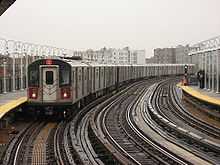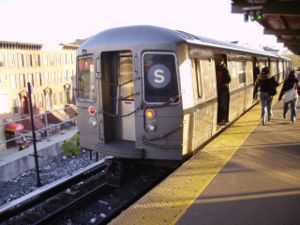R32 (New York City Subway car)
| R32 (New York City Subway car) | |
|---|---|
|
| |
|
Interior of an R32 car. | |
| In service | 1964-Present |
| Manufacturer | Budd Company |
| Built at | Philadelphia |
| Replaced | BMT Standard, BMT D Triplex |
| Constructed | 1964-1965 |
| Entered service | September 14, 1964 |
| Refurbishment | 1988–1990 |
| Scrapped | 2008- |
| Number built | 600 |
| Number in service | 222 (152 in revenue service during rush hours) |
| Number preserved | 4 (2 used for police training) |
| Number scrapped | 360 (12 in work service) |
| Formation | Married Pairs |
| Fleet numbers |
3350–3949 (3659 renumbered to 3348) |
| Capacity | 50 (seated) |
| Operator | New York City Subway |
| Depot(s) | 207th Street Yard and East New York Yard[1] |
| Service(s) assigned |
|
| Specifications | |
| Car body construction | Stainless steel |
| Train length |
2 car train: 120.25 feet (36.65 m) 4 car train: 240.50 feet (73.30 m) 6 car train: 360.75 feet (109.96 m) 8 car train: 481 feet (147 m) 10 car train: 601.25 feet (183.26 m) |
| Car length | over coupler faces: 60 ft 3 in (18.36 m) |
| Width | 10 ft (3,048 mm) |
| Height | 12.08 ft (3,682 mm) |
| Platform height | 3.76 ft (1.15 m) |
| Entry | little small plank |
| Doors | 8 |
| Maximum speed | 55 mph (89 km/h) |
| Weight |
79,930 lb (36,260 kg) (post-rebuild) (70,000 lb or 31,751 kg when delivered) |
| Traction system |
General Electric SCM 17KG192E3, DC propulsion system using GE 1257E1 motors or Westinghouse 1447JR (115 hp or 86 kW per axle) (retired R32GE cars used 115 hp or 86 kW 1257F motors, all subway train cars originally had Westinghouse 1447JR motors, as do all remaining cars in service) |
| Electric system(s) | 600 V DC Third rail |
| Current collection method | Contact shoe |
| Braking system(s) | WABCO RT2 SMEE braking system, A.S.F. simplex unit cylinder clasp (tread) brake |
| Safety system(s) | emergency brakes |
| Coupling system | Westinghouse H2C |
| Headlight type | halogen light bulb |
| Track gauge | 4 ft 8 1⁄2 in (1,435 mm) |
The R32 is a New York City Subway car model built in 1964-65 by the Budd Company in Philadelphia for the IND/BMT B Division. These cars were the first mass-produced stainless steel cars built for the New York City Subway. The two previous Budd orders, the BMT Zephyr and the R11 contract, were limited production orders. Their horizontally ribbed, shiny, and unpainted stainless exteriors earned the cars the nickname Brightliners.
A ceremonial introduction trip for the new R32 "Brightliners" cars was held on September 9, 1964, operating from the New York Central Railroad's Mott Haven Yards in the Bronx to Grand Central Terminal in Midtown Manhattan. The new cars were then placed into service on the Q train on September 14, 1964, after their New York Central's spring loaded under-running third rail shoes were replaced with gravity type overrunning subway third rail shoes.
They are the oldest cars in passenger service on the New York City Subway at 50 years old (the longest for an R-type car), well past the specified service life of 35 years and, according to railfan James Greller,[2] often cited for their superior durability and craftsmanship. They are also the only cars currently in service that were built for the New York City Transit Authority prior to its merger with the Metropolitan Transportation Authority in 1968. Five other car types built after them have been mostly or completely retired,[2] though most R32s have been retired as well.
Since 2010, the Straphangers Campaign surveys have been finding that the R32s, currently assigned to operate in C service, have the lowest Mean Distance Between Failures figures, as the overhauls they received during the 1988-89 period were all worn out after 24-25 years.[3][4][5] In August 2011, the New York Times called the R32s "a dreary reminder to passengers of an earlier subterranean era," and said that "time has taken a toll" on the cars.[2]
Background
The designation R32 is derived from the contract number under which the cars were purchased. The R32s were originally assigned to the BMT Southern Division service only, initially on the Brighton Line (Q train) and the Sea Beach Line (N train), and eventually on the West End Line (T and TT trains).
History
The R32 contract was divided into two subcontracts of 300 cars each: the R32s and R32As. The R32As were funded through the proceeds of a revenue bond while the R32s were paid for out of the 1963-64 New York City capital budget. The two subcontracts differed only in interior lighting (R32 Interior Lighting:,[6] R32A Interior Lighting featuring backlit ad-signs[7]).
In 1964, the New York City Transit Authority contracted with Budd for 600 IND/BMT cars (300 pairs) to replace older equipment, including the BMT D-type Triplex articulated cars and some of the BMT Standards. Budd had bid on previous contracts with the NYCTA, but had never won a City contract for a production run of cars until the R32s, as Budd built only stainless-steel equipment and the TA refused to allow a differential in competitive bids for this higher-quality construction.
Budd won the contract by offering the lowest bid of $117,000 per car. Budd low-balled the price to win the contract and introduce stainless steel equipment to the modern New York City subway system, a plan that was met with limited success. NYCTA allowed a premium for subsequent stainless steel contracts, and all subsequent equipment was at least partly constructed of stainless steel. However, the Budd Company never benefited from the change, as Budd failed to win further contracts from the NYCTA and the company has since halted production of railroad cars.
The last four of these cars (3946-3949) were delivered with Pioneer trucks with disc brakes in 1966. These trucks were replaced with standard trucks in 1976.[8]
These cars were also the first to introduce all mylar route and destination rollsigns instead of the former cotton cloth or linen type rollsigns found on all older cars.
From 1988 to 1990, as part of the NYCTA General Overhaul (GOH) program, the R32 cars were rebuilt by Morrison Knudsen at its shops in Hornell, New York. Ten R32 cars, which have since been retired, were rebuilt by General Electric in its Buffalo, New York facility. After rebuilding, they received Luminator flipdot signs that displayed the service letter only, since the air conditioning evaporators mounted on the interior car ends made it rather difficult to change the front route and destination signs. During the rebuilding process, the route and destination mylar rollsigns located above the storm doors were removed and replaced with flipdot electronic route signs. The distinctive marker lights were also removed.
The R32s are numbered 3350-3949. One car (since scrapped) was originally numbered 3659, but following the loss its even-numbered mate in an accident, it was rebuilt as an even-numbered car and renumbered to 3348. Another car numbered 3669 was retired following a derailment, so its even-numbered mate 3668 was rebuilt into an odd-numbered car and renumbered to 3669.
After refurbishment, R32 and R32A cars were renamed R32 Phase I, R32 Phase II, and R32 GE, with the former of the three types being the only one in service today. The R32 Phase I cars (re-built by Morrison Knudsen) have WABCO Air Brake packages, GE Master Controllers, and Thermo King HVAC units. The R32 Phase II cars (also re-built by Morrison Knudsen) have NY Air Brake equipment, Westinghouse Master Controllers, and Stone Safety HVAC units. Since the cars were sent out to be overhauled based on how poorly they were performing (worst first), there are R32s and R32As in both Phase I and Phase II. There are also about a dozen or more pairs which are composed of R32 and R32A mixes. The ten R32 GEs are slightly different from their Phase I and II brothers as they were rebuilt to R38 specifications with experimental Sigma HVAC Units powered by A/C motors and solid state inverters, and since they had their original traction motors rebuilt to 115 horsepower instead of the traditional 100 horsepower units, featuring backlit ad signs, and somewhat different bulkhead designs.[9][10]
The R160 fleet was intended to replace the entire R32 fleet in the late 2000s, but this plan was halted due to structural issues found on the R44s that led to their retirement. The 10 GE and all Phase II R32s have been retired, as well as some Phase I cars. After retirement, many of those cars were stripped and sunk as artificial reefs. However, since 2010, retired R32s have been trucked to Sims Metal Management's Newark facility to be scrapped and processed.[11]
The remaining cars are maintained at the 207th Street Yard and East New York Yard, running on the C, J and Z trains, with one set assigned to the A. Ten cars are maintained at the 36th-38th Street Yard and used for work service, and two more are maintained at the Coney Island Yard and also used for work service.
As of July 2008, cars 3352-3353 are slated for preservation by the New York Transit Museum.[12] These cars were the lead set on the R32s' premiere trip on September 9, 1964. Cars 3350-3351 have also been set aside for preservation by the Railway Preservation Corp., while G.E. cars 3594-3595 were moved to Floyd Bennett Field for anti-terrorism training.
The remaining cars have undergone SMS (Scheduled Maintenance Service) or a Life Extension Program, at a cost of $24 million, to extend their useful lives through 2017.[2][13][14] They are expected to be replaced by the R179 fleet beginning in 2016.[15][16]
In popular culture
The cars in the 2008 video game Grand Theft Auto IV are based on both R32 and R38 fleets. All cars in the game are heavily vandalized with graffiti.
References
- ↑ New York Subway Barn Assignments
. December 2014 - ↑ 2.0 2.1 2.2 2.3 Grynbaum, Michael M. (26 August 2011). "For Often-Late Cars of Subway’s C Train, Retirement Must Wait". The New York Times. Retrieved 26 August 2011.
- ↑ "C Line profile" (PDF). Straphangers Campaign. Retrieved 17 January 2015.
- ↑ "C Line profile" (PDF). Straphangers Campaign. Retrieved 17 January 2015.
- ↑ "C Line profile" (PDF). Straphangers Campaign. Retrieved 1 December 2014.
- ↑ "Showing Image 4982". Nycsubway.org. Retrieved 2013-11-04.
- ↑ "Showing Image 4981". Nycsubway.org. Retrieved 2013-11-04.
- ↑ "Showing Image 45677". nycsubway.org.
- ↑ "Showing Image 2352". nycsubway.org.
- ↑ "Showing Image 38065". nycsubway.org.
- ↑ "Showing Image 140231". nycsubway.org.
- ↑ "Showing Image 88797". Nycsubway.org. 2009-08-16. Retrieved 2013-11-04.
- ↑ Page 11 of Document, Page 17 on the PDF reader
- ↑
- ↑ "Governor Cuomo Announces $600 Million MTA Investment in Upstate Manufacturing | Governor Andrew M. Cuomo". Governor.ny.gov. 2012-03-28. Retrieved 2013-11-04.
- ↑ http://mta.info/mta/news/books/docs/r_179_staff_summary_March_2012.pdf
Further reading
- Sansone, Gene. Evolution of New York City subways: An illustrated history of New York City's transit cars, 1867-1997. New York Transit Museum Press, New York, 1997 ISBN 978-0-9637492-8-4
External links
| Wikimedia Commons has media related to R32 (New York City Subway car). |
- nycsubway.org - NYC Subway Cars: R32
- BMT-IND Car Assignments - December 7, 2014
- New York City Subway Car Fleet June 2010 through June 2014
| |||||||||||||||||||||||||||||||||||||||||||||||||||||||||||
| ||||||||||||||||


